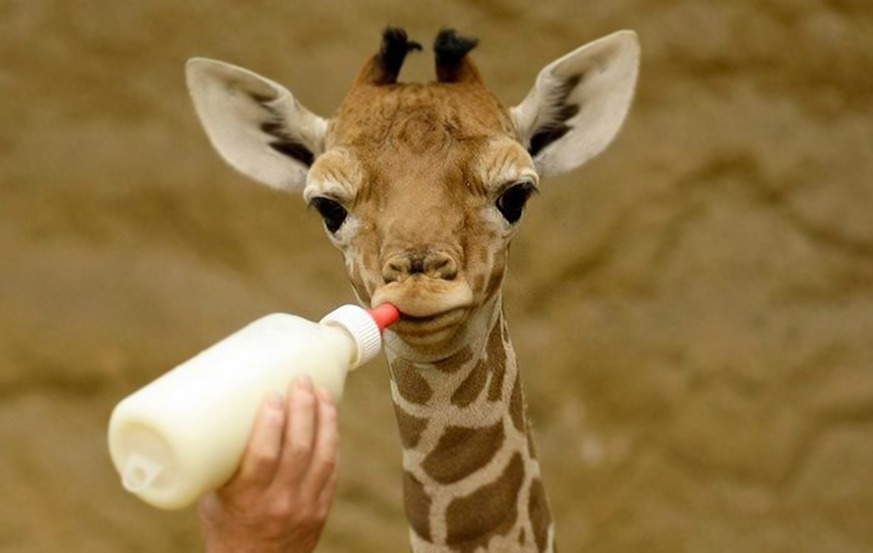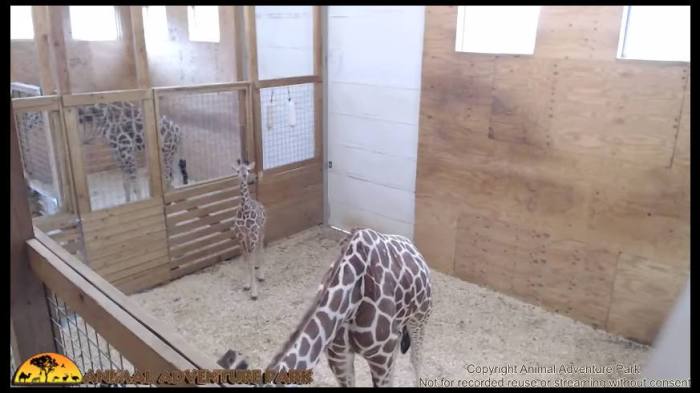The world is watching the live stream and waiting for April the giraffe to share her stall with her giraffe baby, but what happens after April gives birth? Here are some facts about giraffes, their babies and how they are born.
How big will April’s newborn be?
A giraffe calf is typically six feet tall and weighs between 100 and 150 pounds at birth. Giraffe moms are usually pregnant for 15 months. Although Animal Adventure Park’s vet, Dr. Tim, said April isn’t alarmingly overdue, that bun has been in the oven for about 17 months.
When will the baby giraffe be able to walk?
The baby giraffe should be able to walk anywhere from 30 minutes to an hour after birth. The calf will need to stand in order to nurse. After about 10 hours, baby giraffes should be able to run and keep up the herd.
What will the baby eat?
After about four months of nursing, a giraffe baby will start to eat solid foods like leaves, but will supplement with nursing and might not wean until six to 17 months.
What can we expect during the baby’s birth?
Most births occur at dawn, Animal Adventure Park said, but not all of them. The front hooves will come out first followed by the snout. The baby will fall from a height, but no worries! All baby giraffes are born that way and plop onto the ground.
How would a zoo get a giraffe ready for pregnancy and birth?
Animals are capable of doing this on their own, but human intervene to make sure all precautions are taken to ensure a healthy newborn and safe delivery. Animals in captivity are often exposed to technology and devices before they are needed. Giraffes might also require a restraint device (GRD) to keep them still during tests like ultrasounds.
What about April? How can we tell if she’s in labor?
April is 15-years-old and in the wild, that would be the normal life span. However, with human intervention, giraffes can live to 20 to 27 years old. This is April’s fourth calf. The previous births went well and April might even be strong enough to bear more babies.
Instinctively, giraffes hide their labor so as not to draw attention from predators. Some predators will wait until a giraffe gives birth and attack the baby as soon as it is born. Once sign labor is close is when a giraffe’s water breaks, which can be a trickle of liquid or a heavier flow of mucus.
Why is Oliver in a separate pen?
“They are together simply because to isolate them would cause further stress,” the park said when answering questions from live stream viewers. “They are both pretty well behaved, but I once tangoed with Oliver in the yard and that was the last time for that.”
Male giraffes, bulls, like to fight, eat and mate, so he is kept apart to avoid hurting April, her baby and to keep him from eating her food, which includes a special pellet for expectant mothers.
Male giraffes don’t take part in raising their off-spring. After the calf grows, it will be moved to another facility. Keeping families together increases the risk of incestuous mating which would weaken the next generation’s genetics and reduce the species’ chances of survival.
Giraffe fun facts
- There is not only one species of giraffe, but potentially four species of giraffes in the wild.
- There are nine known subspecies. The most common subspecies is the endangered Rothschild’s.
- Giraffes eat about 75 pounds of food daily.
- Giraffes are herbivores and eat mainly leaves. They drink water once every few days; the leaves provide hydration.
- They only sleep for 30 minutes to two hours per day.
- Giraffes can run at speeds up to 35 mph.
- Giraffes can use their strong hoofs to defend themselves and those antennae-looking things on their heads are called ossicones.
- Giraffes can run at speeds up to 35 miles per hour
- Up to 20 feet tall, giraffes are the world’s tallest mammals.
- Male bulls, like Oliver, do not participate in child-rearing. Bulls like to fight and mate.
- Giraffe numbers have declined by 40 percent in the last 30 years.
- Giraffes are now listed as “vulnerable to extinction” on the IUCN Red List.
Donations
There is a GoFundMe for April the giraffe and her growing family set up by Animal Adventure Park. According to the park, it costs more than $50,000 per year to house the giraffes. “A bale of bedding is about $5, a bale of hay $4 and a bag of feed $40,” the park told YouTube viewers.
















